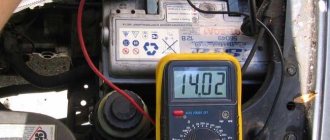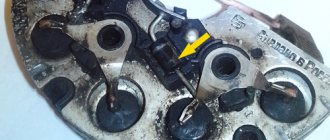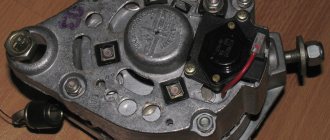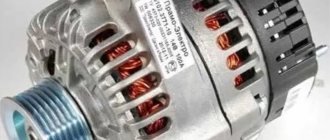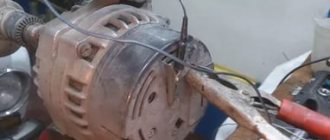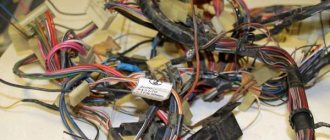During the operation of a car battery, many have probably encountered a problem when, for one reason or another, the battery does not charge. As usual, there may be several reasons. Of course, the question immediately arises whether it is possible to cope with such a situation on your own - especially if it took the motorist by surprise. First, you need to figure out what the reason might be - and, based on the specific situation, make the appropriate decision.
A common cause is terminal oxidation.
When all the electronics of the car, as well as its generator and starter, are working normally, but the battery still does not hold a charge and quickly loses it, the most likely reason for this is oxidation of the terminals. When the car terminals oxidize, a dense white layer forms on them, which prevents the current from fully powering the battery, and the car battery cannot fully take electrical energy to accumulate inside itself.
To prevent such situations, you need to regularly check the condition of the terminals and be sure to clean them , as well as treat them with a special compound that prevents oxidation. The economical option in this case is solid oil, but over time it also greatly degrades electrical conductivity. Therefore, it is better to use lubricants purchased in specialized stores.
If the acid has “eaten through” the terminals thoroughly, they should be replaced immediately. It follows from this that poor or careless care of the car and all its components should not be allowed.
A reason that will surprise many: short trips
Of course, experienced drivers, as well as auto electricians, are well aware that any short trip in the cold winter causes the battery to lose its energy much faster. After all, starting the engine consumes most of the battery power. And if a person gets to work in ten to fifteen minutes, the battery simply does not have time to “swing” during the journey in order to replenish the energy that it lost when starting the engine. This may be another popular reason why the battery does not hold a charge and can discharge so quickly in the winter.
What should you do in such a situation when the battery discharges quickly in winter, during short trips? The answer is simple: to allow the battery to replenish lost capacity, make at least two or at least one trip per week lasting half an hour or more . This will help avoid its premature discharge. In addition, it is recommended to purchase batteries with higher starting currents in advance - specifically with future calculations for “cold start” times.
Car generator malfunctions
When the engine starts running, two indicator lights (red or orange) must light up on all machines. One of them is responsible for the battery, and the other shows the level of oil pressure in the internal combustion engine itself. Both lights stop lighting after the engine starts. But if the battery indicator remains on, it gives the driver a signal that the battery is not receiving electricity from the local current generator , the main function of which is to recharge it while driving.
There may be several possible types of malfunctions due to which the generator does not charge the car battery.
Let's first list them, and then look at each one individually:
- belt drive broke;
- The generator brushes are worn out and need to be replaced.;
- the relay is broken;
- copper stator winding broke.
The generation of electrical energy to recharge the battery on the go occurs in a very simple way. The generator axis, by rotating together with the drive gear, operates on the principle of a conventional electric motor. The axis rotates and electricity is generated. If at least one link of this “belt chain” breaks, the shaft does not rotate and the battery from the generator does not charge.
Alternator brushes also wear out over time. They are located on one side of the generator shaft and help it generate electricity. If they fail, no current flows to the battery either. There is only one way out: replace the old brushes with new ones .
The relay provides a constant current supply to avoid sudden changes in U. If the relay breaks, the battery will not receive electricity to recharge . The relay is also easy to replace.
If the copper winding of the stator shaft is broken, this is another reason why the battery is not charging from the generator. You need to keep in mind that it is much easier to replace the relay and its brushes yourself (of course, with a certain skill). But if the reason lies precisely in the stator shaft, it is better to contact a professional auto repair service with this problem. In this case, the generator will have to be completely disassembled.
The battery is not charging, what is the reason?
A problem with charging the battery may be due to a malfunction of the generator or due to improper operation of the charging control system. Main generator failures:
- Broken pulley (rotates independently of the rotor).
- Loss of contact between the current-collecting brushes and the rotor commutator. Occurs due to critical wear of the brushes, depletion of the working surface of the rotor contact rings, and freezing of the brush pressure springs.
- Voltage regulator malfunction.
- Internal short circuit of the stator winding.
- Failure of the rectifier bridge.
- Short circuit of the rotor winding.
- Slipping of the generator belt due to low tension, oil getting on the working surface, and destruction of the bearings.
The simplest charging control system consists of an excitation circuit that includes a wire and a light on the dashboard. If the red light on the instrument cluster display does not light up, and the battery is not charging from the generator, diagnostics should begin by checking the excitation circuit.
In other design options, in addition to the excitation circuit, a wire is connected through the light bulb to the generator, on which a “+” should appear after the ignition is turned on. Often this circuit is protected by a separate fuse, so if it blows, the battery also does not charge. If the voltage in the excitation circuit is sufficient and all the necessary signals are received by the unit, the cause is a faulty generator.
How to understand that the problem is in the generator
Is there any way to determine that it is the generator that has failed? There are two methods that every driver can always use, even if he is a beginner.
Start the car engine and check the battery voltage . Remember that it should be from 14.2 to 14.7 V. If the U value is less than these numbers, and the indicator light continues to light - one hundred percent, the reason is in the generator.
The second method most likely refers to traditional methods, but it is also no less accurate than checking the voltage. Wear rubber gloves to avoid electric shock and remove one terminal from the battery. If the generator is faulty, the car will immediately stall. And of course, if the generator is not in order, in addition to the constant lighting of the battery indicator light, all electrical devices on board the car will burn dimly.
Replacing Priora generator brushes
The relay regulator is made together with brushes. At first I removed the generator to replace the relay regulator, but this task turned out to be quite labor-intensive due to the inconvenience of its location, especially the Priora with air conditioning and the hose prevents me from doing this. The second time I did not remove the generator.
Disconnected the wires. I took off the back cover, it is secured with three latches on the sides, you just push them out and the cover can be easily removed
Removing the regulator relay was also not difficult; you just need to unscrew the two mounting screws and disconnect the connector from the regulator relay contact.
Putting everything back together wasn't too difficult either. The photo shows the relay regulator after I trimmed the contacts with sandpaper and then put it in place. It turned out to be in working order, but I had already purchased a new relay regulator. For some reason, brushes often fail, especially when you encounter this problem in winter, apparently this is due to high energy consumption due to the heater and loads when starting a cold engine.
And now when the prior generator does not charge, I first check the brushes
The battery does not charge from the charger
It also happens that the battery does not take charge, and this also becomes a problem, the reasons for which should be found out.
The simplest reason is that the battery is completely discharged and cannot “swing” in low-current charging mode. This happens when the battery has not been used for a long time - for example, it has been lying unused for a long time in a store or warehouse. In this case, you can increase the current and try to restore the discharged battery in a more extreme way. In many cases, this method works, and it, being charged with stronger currents, partially restores its performance.
If you try to charge the battery from a charger that is faulty, the battery will also not respond in any way. Then information on how to repair a charger for a car battery will be useful.
The easiest way is to connect it to another charger and, if the process goes well, it will be clear why the battery is not charging. If the battery does not charge again, it means there is a fault inside it.
In any case, if such a problem occurs during scheduled battery charging, the reason lies either in the chargers or in the batteries themselves. It is important to remember that you should always take care of your car battery and check its condition. During charging, the battery should not be left unattended, especially if there is a need to charge it with high currents, or towards the end of the process, while the electrolyte is boiling. If there is negligence on the part of the owner, not only “the battery will not charge,” but also an explosion of the battery and poisoning with harmful chemicals may occur. Read about how to properly charge a car battery with a charger here →
As you can see, there are many reasons why a battery may not take a charge. In some cases, the problem can be solved on your own: it all depends on the logic of the driver and his personal skills in the automotive business. Of course, you should always proceed from your real abilities and, if it is impossible to fix the problem yourself, it is better not to take any risky actions, but to seek help from a competent specialist.
The charger does not see the battery
If the battery does not charge when you connect an external charger, you should measure the voltage at the battery terminals. To supply current to the battery, many chargers need to register a certain minimum voltage at the battery terminals. In other words, the power supply does not see that its terminals are connected to the battery, and therefore does not start the charging process.
To get out of this situation, you will need an additional battery (charge not lower than 10 V) and two wires. To start the charging process, with the device connected, it is enough to connect the positive terminals of the batteries with one wire, and the negative terminals with the second. The charger will register the load and begin charging the battery, after which the wires can be disconnected.
